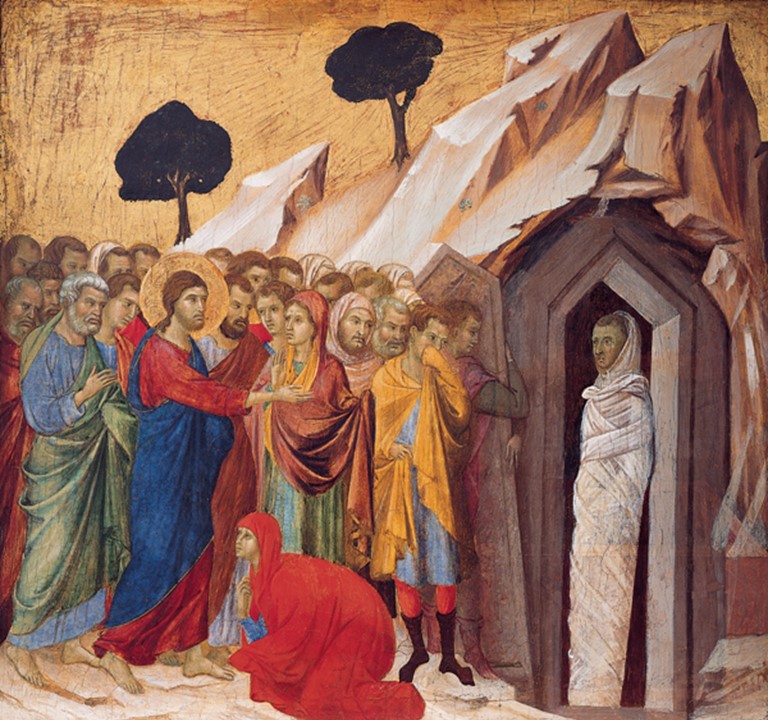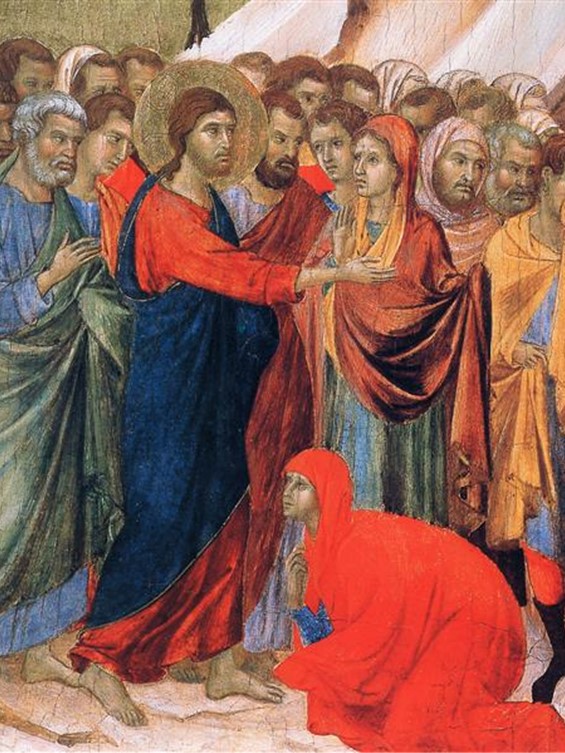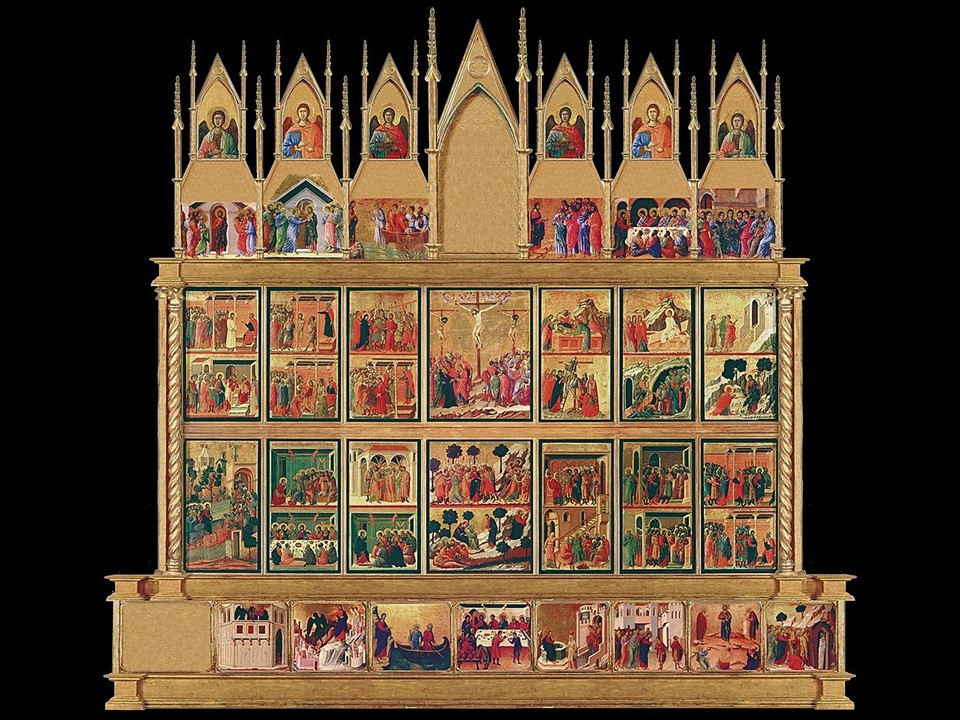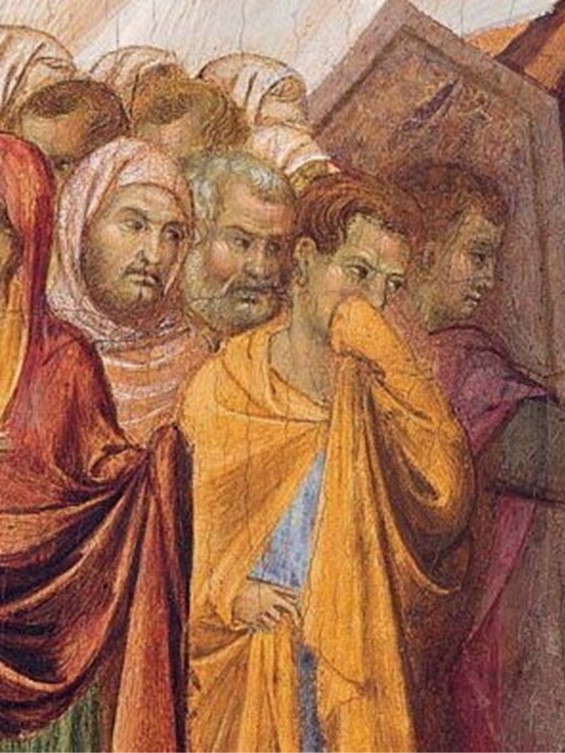
The Raising of Lazarus, 1310–11, Tempera and gold on panel, 43.5 x 46.4 cm, Kimbell Art Museum, Fort Worth, USA https://www.kimbellart.org/collection/apx-197501
Lazarus Saturday… “Six days before the Passover, Jesus came to Bethany…” (John 12:1) and The Raising of Lazarus by Duccio is a wonderful painting to start our 2021 Journey of the Holy Week in the Greek Orthodox Church

The Raising of Lazarus (detail), 1310–11, Tempera and gold on panel, 43.5 x 46.4 cm, Kimbell Art Museum, Fort Worth, USA https://www.wikiart.org/en/duccio/raising-of-lazarus-fragment-1311
Duccio di Buonisegna is one o the greatest Μasters of Early Renaissance Art. Giorgio Vasari in his Lives of the Most Excellent Painters, Sculptors, and Architects, introduces the great Sienese artist with admiration and respect… “Without doubt those who are inventors of anything notable receive the greatest attention from the pens of the writers of history, and this comes to pass because the first inventions are more observed and held in greater marvel, by reason of the delight that the novelty of the thing brings with it, than all the improvements made afterwards by any man whatsoever when works are brought to the height of perfection, for the reason that if a beginning were never given to anything, there would be no advance and improvement in the middle stages, and the end would not become excellent and of a marvellous beauty. Duccio, then, painter of Siena and much esteemed, deserved to carry off the palm from those who came many years after him…” http://www.gutenberg.org/files/25759/25759-h/25759-h.htm#Page_7
My decision to start the 2021 Holy Week in the Greek Orthodox Church presentation with a painting by Duccio was carefully thought. James H. Stubblebine’s 1975 article Byzantine Sources for the Iconography of Duccio’s Maestà triggered my imagination… It was finally in his hands! A centuries-old Manuscript Codex from a Monastery somewhere in the land of ancient Macedonia. He felt curious and lucky and privileged to hold such a treasure in his hands! His spirit lifted, in awe… ideas and images wildly dancing in his head, a tingling sensation going down his hands… he felt the urge to start painting… a spiritual golden world, divine, yet with layered hills and trees effortlessly arranged to create a feeling of depth, ethereal figures clad in spring-like coloured robes… How can I combine His World and mine, he thought, and he started painting… The Art Bulletin, Vol. 57, No. 2 (Jun. 1975), pp. 176-185 (10 pages), Published by CAA https://www.jstor.org/stable/3049368?seq=1. (The text in italics is purely fictional)

Maesta – Back Side, 1310–11, Tempera and gold on panel, Museo dell’Opera del Duomo, Siena, Italy https://en.wikipedia.org/wiki/Maest%C3%A0_(Duccio)#/media/File:Maest_001_duccio_siena_duomo.jpg
In 1771 the Maesta was dismantled and damaged in the process. Few pieces were lost forever, some of its original panels were sold, and today, like orphan siblings, these panels are housed in European or American Museums. I always seek them out when I visit the National Gallery in Washington DC or the National Gallery, for example, in London. Viewing a Duccio panel is always a pleasure! Visiting, however, the Tuscan city of Siena, its splendid Cathedral and finally the first floor of its Museo Dell’Opera, where Duccio’s Maesta is exhibited, I am in “exaltation.” The Duccio Altarpiece, painted from 1308 to 1311 in Siena and exhibited in Sienna “visible from both sides, is one of the most prodigious artistic undertakings of all time.” If I may humbly add, it is also Duccio’s remarkable gesture of respect to the Byzantine artistic tradition, surprisingly still alive in Tuscany of the early fourteenth century. https://operaduomo.siena.it/en/sites/museum/ and https://www.kimbellart.org/collection/apx-197501
“Thus, under Duccio’s aegis, Byzantium had its last, and perhaps noblest stand on the Italian field.” https://www.jstor.org/stable/3049368?seq=1 Page 184
For a Student Activity on Duccio’s The Raising of Lazarus, please… Check HERE!

The Raising of Lazarus (detail), 1310–11, Tempera and gold on panel, 43.5 x 46.4 cm, Kimbell Art Museum, Fort Worth, USA https://twitter.com/roisin_donohoe/status/1276307352501784576/photo/2